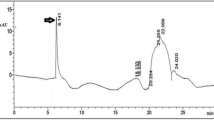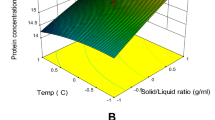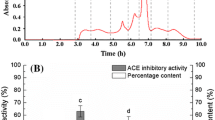Abstract
The antimicrobial peptides derived from microalgae have attracted a huge attention due to the insufficient availability of effective drugs from the natural resources. In this study, the enzymatic hydrolysate of protein derived from Limnospira maxima was prepared using pepsin under optimized conditions. The peptides with range of 10 kDa were isolated and purified using the Ultra membrane filtration, SDS-PAGE, and TLC. Furthermore, the peptide sequence was identified and characterized by MALDI-TOF mass spectrometry in which an algal peptide, KLENCNYAVELGK showed a strong signal at 466.68 m/z among seven peptides derived from the pepsin hydrolysate. The FT-IR spectroscopic study confirmed the presence of a characteristic functional group of amino acids in the sequence. The algal derived peptide showed antibacterial properties against Escherichia coli (27 ± 0.5 mm) and Staphylococcus aureus (14 mm ± 0.5). This study paves a way to explore the antibacterial peptide from a novel species, L. maxima (MZ26519) evident to utilize for the novel drug to overcome the conventional approach.





Similar content being viewed by others
References
Sun, Y., Chang, R., Li, Q., & Li, B. (2016). Isolation and characterization of an antibacterial peptide from protein hydrolysates of Spirulina platensis. European Food Research and Technology, 242, 685–692.
Graziani, G., Schiavo, S., Nicolai, M. A., Buono, S., Fogliano, V., Pinto, G., & Pollio, A. (2013). Microalgae as human food: Chemical and nutritional characteristics of the thermo-acidophilic microalga Galdieria sulphuraria. Food and Function, 4, 144–152.
Wang, Q., Lu, Y., Xin, Y., Wei, L., Huang, S., & Xu, J. (2016). Genome editing of model oleaginous microalgae Nannochloropsis spp. by CRISPR/Cas9. Plant Journal, 88(6), 1071–1081.
Hu, Y., Gong, M., Feng, S., Xu, C. C., & Bassi, A. (2019). A review of recent developments of pre-treatment technologies and hydrothermal liquefaction of microalgae for bio-crude oil production. Renewable and Sustainable Energy Reviews, 101, 476–492.
Chen, G. W., & Yang, M. H. (2021). Production and purification of novel hypocholesterolemic peptides from lactic fermented Spirulina platensis through high hydrostatic pressure-assisted protease hydrolysis. Catalysts, 11(8), 873.
Sathya, R., MubarakAli, D., Mohamed Saalis, J., & Kim, J. M. (2021). A systemic review on microalgal peptides: Bioprocess and sustainable applications. Sustainability, 13(6), 3262.
Chalamaiah, M., Yu, W., & Wu, J. (2018). Immunomodulatory and anticancer protein hydrolysates (peptides) from food proteins: A review. Food Chemistry, 245, 205–222.
Bahari, A. N., Saari, N., Salim, N., & Ashari, S. E. (2020). Response factorial design analysis on papain-generated hydrolysates from Actinopyga lecanora for determination of antioxidant and antityrosinase activities. Molecules, 25, 2663.
Lafarga, T. (2020). Cultured microalgae and compounds derived thereof for food applications: Strain selection and cultivation, drying, and processing strategies. Food Review International, 36(6), 559–583.
Zhu, Y., Zhao, X., Zhang, X., Liu, H., & Ao, Q. (2021). Amino acid, structure and antioxidant properties of Haematococcus pluvialis protein hydrolysates produced by different proteases. International Journal of Food Science and Technology, 5, 185–195.
Lu, J., Sawano, Y., Miyakawa, T., Xue, Y. L., Cai, M. Y., Egashira, Y., Ren, D. F., & Tanokura, M. (2011). One-week antihypertensive effect of Ile-Gln-Pro in spontaneously hypertensive rats. Journal of Agriculture and Food Chemistry, 59(2), 559–563.
Kim, N. H., Jung, S. H., Kim, J., Kim, S. H., Ahn, H. J., & Song, K. B. (2014). Purification of an iron-chelating peptide from spirulina protein hydrolysates. Journal of Applied Biological Chemistry, 57(1), 91–95.
Yu, J., Hu, Y., Xue, M., Dun, Y., Li, S., Peng, N., Liang, Y., & Zhao, S. (2016). Purification and identification of antioxidant peptides from enzymatic hydrolysate of Spirulina platensis. Journal of Microbiology Technology, 26(7), 1216–1223.
Heo, S. Y., Ko, S. C., Kim, C. S., Oh, G. W., Ryu, B., Qian, Z. J., Kim, G., Park, W. S., Choi, I. W., Phan, T. T. V., Heo, S. J., Kang, D. H., Yi, M., & Jung, W. K. (2017). A heptameric peptide purified from Spirulina sp. gastrointestinal hydrolysate inhibits angiotensin I-converting enzyme-and angiotensin II-induced vascular dysfunction in human endothelial cells. International Journal Mol Med, 39(5), 1072–1082.
Wang, Z., & Zhang, X. (2017). Isolation and identification of anti-proliferative peptides from Spirulina platensis using three-step hydrolysis. Journal of the Science of Food and Agriculture, 97(3), 918–922.
He, Y. Y., Li, T. T., Chen, J. X., She, X. X., Ren, D. F., & Lu, J. (2018). Transport of ACE inhibitory peptides ile-Gln-pro and Val-Glu-pro derived from Spirulina platensis across Caco-2 monolayers. Journal of Food Science, 83(10), 2586–2592.
Zeng, Q. H., Wang, J. J., Zhang, Y. H., Song, Y. Q., Liang, J. L., & Zhang, X. W. (2020). Recovery and identification bioactive peptides from protein isolate of Spirulina platensis and their in vitro effectiveness against oxidative stress-induced erythrocyte hemolysis. Journal of the Science of Food and Agriculture, 100(9), 3776–3782.
Wang, K., Luo, Q., Hong, H., Liu, H., & Luo, Y. (2021). Novel antioxidant and ACE inhibitory peptide identified from Arthrospira platensis protein and stability against thermal/pH treatments and simulated gastrointestinal digestion. International Food Research, 139, 109908.
Ma, J., Zeng, X., Zhou, M., Cheng, L., & Ren, D. (2021). Inhibitory effect of low-molecular-weight peptides (0–3 kDa) from Spirulina platensis on H2O2-induced oxidative damage in L02 human liver cells. Bioresource Bioprocess, 8(1), 1–9.
Zhang, N., Li, F., Zhang, T., Li, C.Y., Zhu, L., & Yan, S. (2022) Isolation, identification, and molecular docking analysis of novel ACE inhibitory peptides from Spirulina platensis. European Food Research and Technology 1–9
MubarakAli, D., Baldev, E., Thajuddin, N., Lee, S. Y., & Kim, J. W. (2018). An evidence of C16 fatty acid methyl esters extracted from microalga for effective antimicrobial and antioxidant property. Microbial Pathogenesis, 115, 233–238.
Pereira, A. M., Lisboa, C. R., Santos, T. D., & Costa, J. A. V. (2019). Bioactive stability of microalgal protein hydrolysates under food processing and storage conditions. Journal of Food Science and Technology, 56(10), 4543–4551.
MubarakAli, D., MohamedSaalis, J., Sathya, R., Irfan, N., & Kim, J. W. (2021). An evidence of microalgal peptides to target spike protein of COVID-19: In silico approach. Microbial Pathogenesis, 160, 105189.
Desikachary, T. V. (1959). Cyanophyta Indian Council of Agricultural Research (pp. 3–616). New Delhi.
Kant, S., & Gupta, P. (1998). Algal Flora of Ladakh. Scientific Publishers, Jodhpur, India, ISBN-13: 9788172331658, 341.
Smoker, J. A., & Barnum, S. R. (1988). Rapid small-scale DNA isolation from filamentous Cyanobacteria. FEMS Microbiology Letters, 56(1), 119–122.
Pandiaraj, D., Mubarak Ali, D., Praveen Kumar, R., Ravikumar, S., & Thajuddin, N. (2012). Molecular characterization and phylogeny of Marine cyanobacteria from Palk Bay region of Tamil Nadu, India. Ecologia, 2(1), 23–30.
Lowry, O. H., Rosebrough, N. J., Farr, A. L., & Randall, R. J. (1951). Protein measurement with the Folin phenol reagent. Journal of Biological Chemistry, 193, 265–275.
Vo, T. S., Ryu, B., & Kim, S. K. (2013). Purification of novel anti-inflammatory peptides from enzymatic hydrolysate of the edible microalgal Spirulina maxima. Journal of Functional Foods, 5(3), 1336–1346.
Laemmli, U. K. (1970). Cleavage of structural proteins during the assembly of the head of bacteriophage T4. Nature, 227(5259), 680–685.
Ghani, N., Shahzadi, N., Sadaf, S., Ullah, I., Ali, E., Iqbal, J., Rafique, T., & Maqbool, M. (2020). Isolation of several indigenous microalgae from Kallar Kahar Lake Chakwal Pakistan. Iran Journal of Biotechnology, 18(3), e2214.
Powers, J. P. S., & Hancoc, R. E. (2003). The relationship between peptide structure and antibacterial activity. Peptides, 24(11), 1681–1691.
Zhang, Y. Z., Chen, X. L., Zhou, B. C., Zeng, C. K., Liu, J., Shi, D. X., & Pang, S. J. (1999). A new model of phycibilisome in Spirulina platensis. Science in China Series C, 42, 74–79.
Kamble, S. P., Gaikar, R. B., Padalia, R. B., & Shinde, K. D. (2013). Extraction and purification of C-phycocyanin from dry Spirulina powder and evaluating its antioxidant, anticoagulation and prevention of DNA damage activity. Journal of Pharmacy and Pharmaceutical Sciences, 3, 149–153.
Sudhir, P. R., Pogoryelov, D., Kovacs, L., Garab, G., & Murthy, S. D. S. (2005). The effects of salt stress on photosynthetic electron transport and thylakoid membrane proteins in the cyanobacterium Spirulina platensis. International Journal of Biochemistry and Molecular Biology, 38, 481–485.
Schmid, F.X. (2001). Biological macromolecules: UV‐visible spectrophotometry.
Arief, K., Trilestari, J., Sunarso, N., Indraswati, S., & Ismadji, S. (2008). Recent progress on biosorption of heavy metals from liquids using low cost biosorbents: Characterization, biosorption parameters and mechanism studies: A review. Clean, 36, 937–962.
Sert, Y., Sreenivasa, S., Dogan, H., Mohan, N. R., Suchetan, P. A., & Ucun, F. (2014). Vibrational frequency analysis, FT-IR and Laser-Raman spectra, DFT studies on ethyl (2E)-2-cyano-3-(4-methoxyphenyl)-acrylate. Spectrochimica Acta Part A: Molecular and Biomolecular Spectroscopy, 130, 96–104.
Colthup, N.B., Daly, L.H., & Lawrence, H. W. (1990). Introduction to infrared and Raman spectroscopy. 3rd Edn., Academic Press, New York, ISBN: 10: 012182554X.
Varsanyi, G. (1974). Assignments of Vibrational Spectra of 700 Benzene Derivatives. Wiley.
Welna, M., Szymczycha-Madeja, A., & Zirnicki, W. (2013). Applicability of ICPOES, UV-VIS and FT-IR methods for the analysis of coffee products. Analytical Letters, 46, 2927–2940.
Bykov, G. L., & Ershov, B. G. (2009). Sorption of uranyl ions on phosphorylated lignin. Radiochemistry, 51(3), 292–294.
Riaz, T., Zeeshan, R., Zarif, F., Ilyas, K., Muhammad, N., Safi, S. Z., Syed, A. R., Rizvi, A. A., & Rehman, I. U. (2018). FTIR analysis of natural and synthetic collagen. Applied Spectroscopy Reviews, 53(9), 703–746.
Lupaescu, A. V., Jureschi, M., Ciobanu, C. I., Ion, L., Zbancioc, G., Petre, B. A., & Drochioiu, G. (2019). FTIR and MS evidence for heavy metal binding to anti-amyloidal NAP-like peptides. International Journal of Peptide Research and Therapeutics, 25(1), 303–309.
Chen, H. M., Muramoto, K., & Yamauchi, F. (1995). Structural analysis of antioxidative peptides from soybean beta-conglycinin. Journal of Agriculture and Food Chemistry, 43(3), 574–578.
Shahidi, F., & Zhong, Y. (2008). Bioactive peptides. Journal of AOAC International, 91(4), 914–931.
Pazdrak, K., Young, T. W., Straub, C., Stafford, S., & Kurosky, A. (2011). Priming of eosinophils by GM-CSF is mediated by protein kinase CβII-phosphorylated L-plastin. The Journal of Immunology, 186(11), 6485–6496.
Cao, D., Lv, X., Xu, X., Yu, H., Sun, X., & Xu, N. (2017). Purification and identification of a novel ACE inhibitory peptide from marine alga Gracilariopsis lemaneiformis protein hydrolysate. European Food Research and Technology, 243(10), 1829–1837.
Otani, H., & Suzuki, H. (2003). Isolation and characterization of cytotoxic small peptides, α-casecidins, from bovine αs1-casein digested with bovine trypsin. Animal Science Journal, 74(5), 427–435.
Suetsuna, K., & Chen, J. R. (2001). Identification of antihypertensive peptides from peptic digest of two microalgae, Chlorella vulgaris and Spirulina platensis. Marine Biotechnology, 3(4), 305–309.
Amini, A., Rundlöf, T., Lodén, H., Carlsson, J. A., Lavén, M., Mulugeta, E., & Perolari, A. (2021). Identification of peptides and proteins in illegally distributed products by MALDI-TOF-MS. In Mass Spectrometry in Life Sciences and Clinical Laboratory. IntechOpen.
Samarakoon, K. W., O-Nam, K., Ko, J. Y., Lee, J. H., Kang, M. C., Kim, D., & Jeon, Y. J. (2013). Purification and identification of novel angiotensin-I converting enzyme (ACE) inhibitory peptides from cultured marine microalgae (Nannochloropsis oculata) protein hydrolysate. Journal of Applied Phycology, 25(5), 1595–1606.
Sheih, I. C., Fang, T. J., & Wu, T. K. (2009). Isolation and characterisation of a novel angiotensin I-converting enzyme (ACE) inhibitory peptide from the algae protein waste. Food Chemistry, 115(1), 279–284.
Kou, X., Gao, J., Xue, Z., Zhang, Z., Wang, H., & Wang, X. (2013). Purification and identification of antioxidant peptides from chickpea (Cicer arietinum L.) albumin hydrolysates. LWT - Food Science and Technology, 50, 591–598.
Chen, N., Yang, H., Sun, Y., Niu, J., & Liu, S. (2012). Purification and identification of antioxidant peptides from walnut (Juglans regia L.) protein hydrolysates. Peptides, 38, 344–349.
Zhang, Y., Duan, X., & Zhuang, Y. (2012). Purification and characterization of novel antioxidant peptides from enzymatic hydrolysates of tilapia (Oreochromis niloticus) skin gelatin. Peptide, 38, 13–21.
Corrêa, A. P. F., Daroit, D. J., Fontoura, R., Meira, S. M. M., Segalin, J., & Brandelli, A. (2014). Hydrolysates of sheep cheese whey as a source of bioactive peptides with antioxidant and angiotensin-converting enzyme inhibitory activities. Peptides, 6, 48–55.
Liu, J., Jin, Y., Lin, S., Jones, G. S., & Chen, F. (2015). Purification and identification of novel antioxidant peptides from egg white protein and their antioxidant activities. Food Chemistry, 175, 258–266.
Siow, H. L., & Gan, C. Y. (2013). Extraction of antioxidative and antihypertensive bioactive peptides from Parkia speciosa seeds. Food Chemistry, 141(4), 3435–3442.
Agrawal, H., Joshi, R., & Gupta, M. (2017). Isolation and characterisation of enzymatic hydrolysed peptides with antioxidant activities from green tender sorghum. LWT, 84, 608–616.
Santos, O., Pontes, P. V., Santos, J. F., Muricy, G., Giambiagi-deMarval, M., & Laport, M. S. (2010). Isolation characterization and phylogeny of sponge-associated bacteria with antimicrobial activities from Brazil. Research in Microbiology, 161(7), 604–612.
Bolscher, J. G. M., Van der Kraan, M. I. A., Nazmi, K., Kalay, H., Grün, C. H., Van’t Hof, W., Veerman, E. C. I., & Amerongen, A. V. N. (2006). A one-enzyme strategy to release an antimicrobial peptide from the LFampin-domain of bovine lactoferrin. Peptides, 27, 1–9.
Funding
This study was supported by a grant from the Incheon National University in 2018.
Author information
Authors and Affiliations
Contributions
SR: data acquisition and process; MD: review, guidance and proofreading, VN: data processing, guidance, MNM: data acquisition and process, NT: molecular characterization, KJW: review, guidance and proofreading.
Corresponding authors
Ethics declarations
Conflict of Interest
The authors declare no competing interests.
Additional information
Publisher's Note
Springer Nature remains neutral with regard to jurisdictional claims in published maps and institutional affiliations.
Rights and permissions
About this article
Cite this article
R., S., D., M., M.G., M.N. et al. An Investigation of Pepsin Hydrolysate of Short Antibacterial Peptides Derived from Limnospira Sp.. Appl Biochem Biotechnol 194, 5580–5593 (2022). https://doi.org/10.1007/s12010-022-04023-2
Accepted:
Published:
Issue Date:
DOI: https://doi.org/10.1007/s12010-022-04023-2




